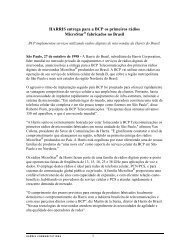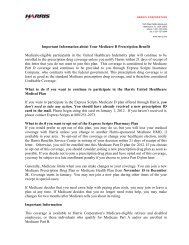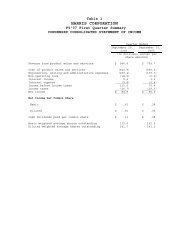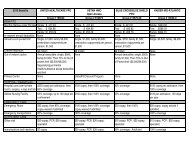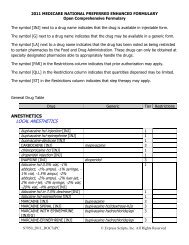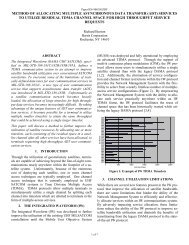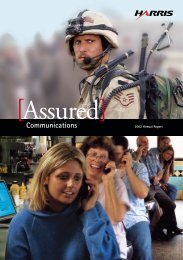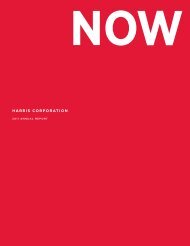OVERCOMING STRESSED SATELLITE NETWORKS USING ...
OVERCOMING STRESSED SATELLITE NETWORKS USING ...
OVERCOMING STRESSED SATELLITE NETWORKS USING ...
You also want an ePaper? Increase the reach of your titles
YUMPU automatically turns print PDFs into web optimized ePapers that Google loves.
can be found in [1]. Figure 1 illustrates the jamming<br />
environment from surface, airborne and space borne<br />
perspectives. These examples cover a broad spectrum of<br />
expected jamming techniques and supply a suitable<br />
baseline that waveforms can be tested against.<br />
Performance characteristics in terms of Bit Error Rate<br />
(BER), Symbol Error Rate (SER) and packet<br />
loss/throughput statistics can be calculated and used to<br />
optimize and further adapt the waveforms.<br />
Harris continues to build from a library of jamming<br />
models built and proven over the last several years.<br />
These proven jammer models facilitated the successful<br />
completion of a proprietary waveform with powerful<br />
Anti-Scintillation (AS) and Anti-Jam (AJ) capabilities.<br />
Such solid analysis structures supply a suitable starting<br />
point for the required analysis. Additionally, cognitive<br />
radios and smart routing capabilities provide other<br />
alternatives for jamming avoidance.<br />
Figure 1. Jammers prevent SATCOM from effectively<br />
transferring critical and timely warfighter information<br />
For effective jamming mitigation techniques, trades<br />
must be made in regard to waveform structure. Symbol<br />
interleaving and interleaving depth come forward as<br />
proven methods for overcoming various jamming<br />
conditions [2, 3]. Specific jamming signals and desired<br />
signals require specific interleaving for optimum stress<br />
protection. These analyses should include running<br />
simulations using sensitivity parameterizations and<br />
characterizations and specific traffic types such as voice,<br />
video and data.<br />
Gaussian noise jammers used against frequency hopped<br />
signals can be larger than the information bandwidth of<br />
the target, but narrower than the total hopped bandwidth<br />
[4]. Termed partial-band jammers, these can in some<br />
instances provide increased effectiveness by grouping<br />
symbol errors and thus defeating the error correction<br />
decoder. Interleaving of sufficient length, as designed<br />
2 of 6<br />
into Harris’ AS/AJ modem, defeats this strategy by<br />
"randomly" spacing out the symbol errors. The AS/AJ<br />
modem resides in the OM-88 Modem System [9].<br />
Figure 2 represents an example AJ Waveform’s<br />
performance against a barrage jammer in a fast-fading<br />
environment and the potential improvement that can be<br />
obtained using appropriate symbol coding and<br />
interleaving. Greater detail using similar methods may<br />
be found in Kosa’s [5] master thesis at the Naval<br />
Postgraduate School. While there are many types of<br />
jammers and many methods of classification, our paper<br />
focuses the discussion on the achievable network<br />
performance with an illustrative method of bypassing the<br />
satellite jamming environment altogether. Bypassing the<br />
jamming environment eliminates the need for more<br />
complex and expensive AJ equipment enabling the use<br />
of traditional and even commercial grade<br />
communications equipment.<br />
Bit Error Rate (BER)<br />
1.E+00<br />
1.E-01<br />
1.E-02<br />
1.E-03<br />
1.E-04<br />
1.E-05<br />
1.E-06<br />
1.E-07<br />
Anti-Jam<br />
1.E-08<br />
0 10 20 30<br />
Eb/No (dB)<br />
Jammed<br />
Figure 2. Significant performance improvements come<br />
from proper waveform formulation and manipulation<br />
Existing alternatives provide a most suitable means to<br />
overcome the effects of stressed communications easing<br />
the analysis requirements. Networking Radios capable<br />
of supplying a high-capacity and a high-availability<br />
readily provide a solution to bypass the jamming<br />
environment.<br />
<strong>NETWORKS</strong> & NETWORK RADIO BASED<br />
TECHNIQUES<br />
Harris’ High-Capacity Wireless Networking [6]<br />
solutions offer flexibility and high-rate networking for<br />
the warfighter. This includes the multi-channel software<br />
defined radio (SDR) based Highband Networking Radio<br />
(HNR) system. The HNR system takes advantage of<br />
robust Line-Of-Sight (LOS) waveforms operating above<br />
2 GHz. Similar SDRs built from proven designs provide




